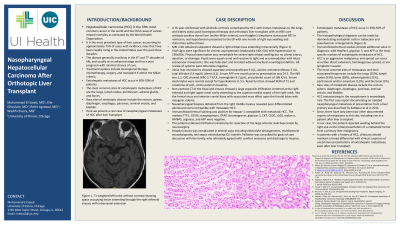Back


Poster Session B - Monday Morning
Category: Liver
B0541 - Nasopharyngeal Hepatocellular Carcinoma After Orthotopic Liver Transplant
Monday, October 24, 2022
10:00 AM – 12:00 PM ET
Location: Crown Ballroom

Has Audio
- ME
Mohammad El-Saied, MD
University of Illinois at Chicago
Chicago, IL
Presenting Author(s)
Mohammad El-Saied, MD1, Elie Ghoulam, MD2, Rohit Agrawal, MD3, Wadih Chacra, MD1
1University of Illinois at Chicago, Chicago, IL; 2University of Ilinois at Chicago, Chicago, IL; 3University of Illinois, Chicago, IL
Introduction: Hepatocellular carcinoma (HCC) is the fifth-most common cancer in the world and the third leading cause of cancer-related death. It accounts for 75% of liver cancers, with rapidly rising incidence rates in the USA. Treatment includes locoregional therapy, chemotherapy, surgery, and transplant if within Milan Criteria. Extrahepatic metastases of HCC occur in 30%-50% of patients. The most common sites include the lungs, lymph nodes, bone, and brain. Here we present a rare case of nasopharyngeal metastases of HCC after liver transplant.
Case Description/Methods: A 76-year-old female with alcoholic cirrhosis complicated by HCC with known metastases to the lungs and kidney status post (s/p) locoregional therapy and orthotopic liver transplant with an HBV core antibody positive donor liver (within Milan criteria), and non-Hodgkin’s lymphoma s/p XRT in remission presented to the ER with one month of right eye swelling and rhinorrhea without fever.
Vital signs were significant for chronic asymptomatic bradycardia and hypertension. Physical examination with right orbital swelling without pupillary or extraocular muscle abnormalities. No neurological deficits were noted.
Liver enzymes were AST 9 U/L, ALT 3 U/L, total bilirubin 0.4 mg/ dL (direct 0.1), INR 1.2. Serum AFP one month prior to presentation was 24.5 ng/mL. CBC showed WBC of 3.7 K/UL, hemoglobin 8.2 g/dL and PLT 186 K/UL. Computed tomography showed a large expansile infiltration centered at the right ethmoid and upper nasal cavity extending to the superior medial aspect of the orbit, with associated mass effect upon the frontal lobes.
Nasopharyngeal biopsies revealed poorly differentiated adenocarcinoma with immunostaining positive for heppar-1 compatible with metastatic HCC. The patient underwent bifrontal craniotomy for resection of the anterior skull base lesion, with a hospital course complicated by encephalopathy and sepsis necessitating ICU. The patient was discharged on comfort measures and hospice.
Discussion: HCC metastasizing to the nasopharynx is exceedingly rare. The first case report documenting an isolated nasopharyngeal metastasis from a liver primary was described by Kattepur et al in 2014. In our case, the patient reported swelling behind the right eye as the initial presentation of a metastatic HCC after liver transplant. In patients with history of HCC, clinicians should maintain a broad differential with clinical suspicion for uncommon presentations of extra hepatic metastases, even after liver transplant.

Disclosures:
Mohammad El-Saied, MD1, Elie Ghoulam, MD2, Rohit Agrawal, MD3, Wadih Chacra, MD1. B0541 - Nasopharyngeal Hepatocellular Carcinoma After Orthotopic Liver Transplant, ACG 2022 Annual Scientific Meeting Abstracts. Charlotte, NC: American College of Gastroenterology.
1University of Illinois at Chicago, Chicago, IL; 2University of Ilinois at Chicago, Chicago, IL; 3University of Illinois, Chicago, IL
Introduction: Hepatocellular carcinoma (HCC) is the fifth-most common cancer in the world and the third leading cause of cancer-related death. It accounts for 75% of liver cancers, with rapidly rising incidence rates in the USA. Treatment includes locoregional therapy, chemotherapy, surgery, and transplant if within Milan Criteria. Extrahepatic metastases of HCC occur in 30%-50% of patients. The most common sites include the lungs, lymph nodes, bone, and brain. Here we present a rare case of nasopharyngeal metastases of HCC after liver transplant.
Case Description/Methods: A 76-year-old female with alcoholic cirrhosis complicated by HCC with known metastases to the lungs and kidney status post (s/p) locoregional therapy and orthotopic liver transplant with an HBV core antibody positive donor liver (within Milan criteria), and non-Hodgkin’s lymphoma s/p XRT in remission presented to the ER with one month of right eye swelling and rhinorrhea without fever.
Vital signs were significant for chronic asymptomatic bradycardia and hypertension. Physical examination with right orbital swelling without pupillary or extraocular muscle abnormalities. No neurological deficits were noted.
Liver enzymes were AST 9 U/L, ALT 3 U/L, total bilirubin 0.4 mg/ dL (direct 0.1), INR 1.2. Serum AFP one month prior to presentation was 24.5 ng/mL. CBC showed WBC of 3.7 K/UL, hemoglobin 8.2 g/dL and PLT 186 K/UL. Computed tomography showed a large expansile infiltration centered at the right ethmoid and upper nasal cavity extending to the superior medial aspect of the orbit, with associated mass effect upon the frontal lobes.
Nasopharyngeal biopsies revealed poorly differentiated adenocarcinoma with immunostaining positive for heppar-1 compatible with metastatic HCC. The patient underwent bifrontal craniotomy for resection of the anterior skull base lesion, with a hospital course complicated by encephalopathy and sepsis necessitating ICU. The patient was discharged on comfort measures and hospice.
Discussion: HCC metastasizing to the nasopharynx is exceedingly rare. The first case report documenting an isolated nasopharyngeal metastasis from a liver primary was described by Kattepur et al in 2014. In our case, the patient reported swelling behind the right eye as the initial presentation of a metastatic HCC after liver transplant. In patients with history of HCC, clinicians should maintain a broad differential with clinical suspicion for uncommon presentations of extra hepatic metastases, even after liver transplant.

Figure: T1 weighted MRI orbit without contrast showing space occupying lesion extending through the right ethmoid sinuses with intracranial extension.
Disclosures:
Mohammad El-Saied indicated no relevant financial relationships.
Elie Ghoulam indicated no relevant financial relationships.
Rohit Agrawal indicated no relevant financial relationships.
Wadih Chacra indicated no relevant financial relationships.
Mohammad El-Saied, MD1, Elie Ghoulam, MD2, Rohit Agrawal, MD3, Wadih Chacra, MD1. B0541 - Nasopharyngeal Hepatocellular Carcinoma After Orthotopic Liver Transplant, ACG 2022 Annual Scientific Meeting Abstracts. Charlotte, NC: American College of Gastroenterology.
